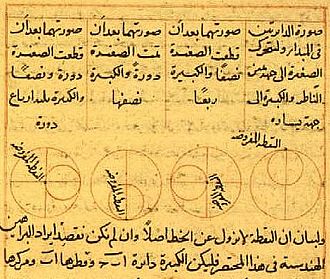
Back العلم في عصر الحضارة الإسلامية Arabic علوم اسلاميه ARZ মধ্যযুগীয় ইসলামি বিশ্বে বিজ্ঞান Bengali/Bangla Nauka u srednjovjekovnom islamskom svijetu BS Ciència i tècnica de l'islam Catalan Islamico ciencia CBK-ZAM زانست لە شارستانییەتی ئیسلامیدا CKB Věda ve středověkém islámském světě Czech ޢުލޫމުލްއިސްލާމް DV Επιστήμη στο μεσαιωνικό Ισλάμ Greek

Science in the medieval Islamic world was the science developed and practised during the Islamic Golden Age under the Abbasid Caliphate of Baghdad, the Umayyads of Córdoba, the Abbadids of Seville, the Samanids, the Ziyarids and the Buyids in Persia and beyond, spanning the period roughly between 786 and 1258. Islamic scientific achievements encompassed a wide range of subject areas, especially astronomy, mathematics, and medicine. Other subjects of scientific inquiry included alchemy and chemistry, botany and agronomy, geography and cartography, ophthalmology, pharmacology, physics, and zoology.
Medieval Islamic science had practical purposes as well as the goal of understanding. For example, astronomy was useful for determining the Qibla, the direction in which to pray, botany had practical application in agriculture, as in the works of Ibn Bassal and Ibn al-'Awwam, and geography enabled Abu Zayd al-Balkhi to make accurate maps. Islamic mathematicians such as Al-Khwarizmi, Avicenna and Jamshīd al-Kāshī made advances in algebra, trigonometry, geometry and Arabic numerals. Islamic doctors described diseases like smallpox and measles, and challenged classical Greek medical theory. Al-Biruni, Avicenna and others described the preparation of hundreds of drugs made from medicinal plants and chemical compounds. Islamic physicists such as Ibn Al-Haytham, Al-Bīrūnī and others studied optics and mechanics as well as astronomy, and criticised Aristotle's view of motion.
During the Middle Ages, Islamic science flourished across a wide area around the Mediterranean Sea and further afield, for several centuries, in a wide range of institutions.